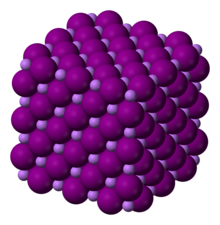

 | |

| |
| Identifiers | |
|---|---|
|
| |
3D model (JSmol) |
|
| ChemSpider |
|
| ECHA InfoCard | 100.030.735 |
PubChem CID |
|
| UNII |
|
CompTox Dashboard (EPA) |
|
| |
| |
| Properties | |
| LiI | |
| Molar mass | 133.85 g/mol |
| Appearance | White crystalline solid |
| Density | 4.076 g/cm3 (anhydrous) 3.494 g/cm3 (trihydrate) |
| Melting point | 469 °C (876 °F; 742 K) |
| Boiling point | 1,171 °C (2,140 °F; 1,444 K) |
| 1510 g/L (0 °C) 1670 g/L (25 °C) 4330 g/L (100 °C) [1] | |
| Solubility | soluble in ethanol, propanol, ethanediol, ammonia |
| Solubilityinmethanol | 3430 g/L (20 °C) |
| Solubilityinacetone | 426 g/L (18 °C) |
| −50.0·10−6cm3/mol | |
Refractive index (nD) |
1.955 |
| Thermochemistry | |
Heat capacity (C) |
0.381 J/g K or 54.4 J/mol K |
Std molar |
75.7 J/mol K |
Std enthalpy of |
-2.02 kJ/g or −270.48 kJ/mol |
Gibbs free energy (ΔfG⦵) |
-266.9 kJ/mol |
| Hazards | |
| NFPA 704 (fire diamond) | |
| Flash point | Non-flammable |
| Safety data sheet (SDS) | External MSDS |
| Related compounds | |
Other anions |
Lithium fluoride Lithium chloride Lithium bromide Lithium astatide |
Other cations |
Sodium iodide Potassium iodide Rubidium iodide Caesium iodide Francium iodide |
Except where otherwise noted, data are given for materials in their standard state (at 25 °C [77 °F], 100 kPa). | |
Lithium iodide, or LiI, is a compoundoflithium and iodine. When exposed to air, it becomes yellow in color, due to the oxidation of iodide to iodine.[2] It crystallizes in the NaCl motif.[3] It can participate in various hydrates.[4]

Lithium iodide is used as a solid-state electrolyte for high-temperature batteries. It is also the standard electrolyte in artificial pacemakers[6] due to the long cycle life it enables.[7] The solid is used as a phosphor for neutron detection.[8] It is also used, in a complex with Iodine, in the electrolyteofdye-sensitized solar cells.
Inorganic synthesis, LiI is useful for cleaving C-O bonds. For example, it can be used to convert methyl esters to carboxylic acids:[9]
Similar reactions apply to epoxides and aziridines.
Lithium iodide was used as a radiocontrast agent for CT scans. Its use was discontinued due to renal toxicity. Inorganic iodine solutions suffered from hyperosmolarity and high viscosities. Current iodinated contrast agents are organoiodine compounds.[10]
It is also useful in MALDI imaging mass spectrometry of lipids by adding lithium salts to the matrix solution
|
Salts and covalent derivatives of the iodide ion
| |||||||||||||||||||||||||||||||||||||||||||||||||||||||||||||||||||||||||||||||||||||||||||||||||||||||||||||||||||||||||||||||||||||||||||||||||||||||||||||||
|---|---|---|---|---|---|---|---|---|---|---|---|---|---|---|---|---|---|---|---|---|---|---|---|---|---|---|---|---|---|---|---|---|---|---|---|---|---|---|---|---|---|---|---|---|---|---|---|---|---|---|---|---|---|---|---|---|---|---|---|---|---|---|---|---|---|---|---|---|---|---|---|---|---|---|---|---|---|---|---|---|---|---|---|---|---|---|---|---|---|---|---|---|---|---|---|---|---|---|---|---|---|---|---|---|---|---|---|---|---|---|---|---|---|---|---|---|---|---|---|---|---|---|---|---|---|---|---|---|---|---|---|---|---|---|---|---|---|---|---|---|---|---|---|---|---|---|---|---|---|---|---|---|---|---|---|---|---|---|---|
| |||||||||||||||||||||||||||||||||||||||||||||||||||||||||||||||||||||||||||||||||||||||||||||||||||||||||||||||||||||||||||||||||||||||||||||||||||||||||||||||
| Authority control databases: National |
|
|---|